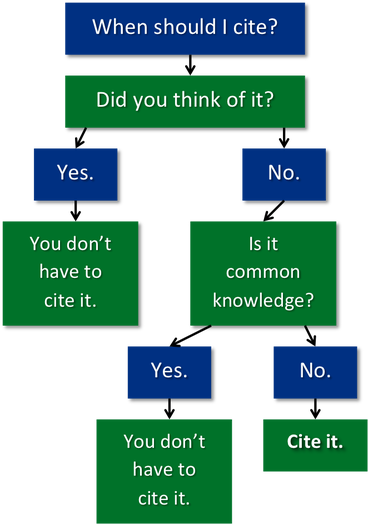Citations
Citations are your best defense against plagiarism. You can be accused of plagiarism when you use someone else's words or ideas without giving credit to your source, whether or not you intended to plagiarize.
|
Include TWO citations for every source:
1. In-Text/Parenthetical Citations appear in the body of your paper alongside the words and/or ideas you borrowed. In MLA format, you should try to include the author and page number, if you know it. These short references are like “breadcrumbs” leading your reader to the longer bibliographic citations at the end of your paper. 2. Bibliographic Citations appear at the end of your paper, and they include all of the important information your reader needs in order to locate the source(s) you have used to write your paper. In MLA format, these longer citations are listed alphabetically on a separate “Works Cited” page and are aligned using a hanging indent. |
In-Text/Parenthetical Citations
Include the author’s last name and the page number, if available. In the case of a website, use only the webpage title if the author’s name is missing. If no page number is given, it is okay to leave it out. No matter what, your in-text/parenthetical citation should match up with the corresponding bibliographic citation.
In-Text Examples
According to Smith, “bees are essential to the ecosystem.”
Jones writes that Gatsby was both proud and ashamed to be a self-made man.
Glenn and Lee, in separate articles, argue that genetic risk factors contribute to the disease.
According to the webpage, “NBA Top Picks,” the best basketball players come from Virginia.
Parenthetical Examples
Despite efforts to replace them, “bees are essential to the ecosystem” (Smith 42).
According to one critic, Gatsby was both proud and ashamed of being a self-made man (Jones 86).
Researchers agree that genetic risk factors contribute to the disease (Glenn and Lee).
According to a respected source, the best NBA players come from Virginia (“NBA Top Picks”).
Need more help? Check out the OWL at Purdue's in-text citation page or see the librarian.
In-Text Examples
According to Smith, “bees are essential to the ecosystem.”
Jones writes that Gatsby was both proud and ashamed to be a self-made man.
Glenn and Lee, in separate articles, argue that genetic risk factors contribute to the disease.
According to the webpage, “NBA Top Picks,” the best basketball players come from Virginia.
Parenthetical Examples
Despite efforts to replace them, “bees are essential to the ecosystem” (Smith 42).
According to one critic, Gatsby was both proud and ashamed of being a self-made man (Jones 86).
Researchers agree that genetic risk factors contribute to the disease (Glenn and Lee).
According to a respected source, the best NBA players come from Virginia (“NBA Top Picks”).
Need more help? Check out the OWL at Purdue's in-text citation page or see the librarian.
BIbliographic Citations
Every source is different, so it is important to take advantage of helpful resources such as MyBib, the OWL at Purdue, and the MLA Handbook, when formatting original bibliographic citations. These resources provide how-to instructions and fillable forms to arrange and punctuate the common bibliographic citation elements, which are the following:
Author. "Title of source." Title of Container, Other contributors, Version, Number, Publisher, Publication date, Location.
EXAMPLES
BOOK Smith, Paul. Fast Cars. Yardley Books, 2015.
WEBSITE Riley, Cate. “Schools of the Future.” Education News, www.education-news.com/schools-of-the-future.
IMAGE @photoSam. “Cute Cats.” Adorable Animal Archive, Apr. 2014, www.adorableanimals.com/cats-10843587.
SONG The Strange Scene. “Another Rotation.” We Stand Together, 2016.
VIDEO CheapSkate. “World’s Best Roller Rinks.” YouTube, 27 Mar. 2016, youtu.be/abcd123.
FILM Porter, Alica, director. The Muse of Mischief. United Artists, 2011.
DATABASE Garber, Everly, et al. “Echolocation Impact of Nocturnal Migration Ranges.” Journal of Marine Biology, vol. 34, no. 2, 16
May 2016, pp. 198-216. JSTOR, www.jstor.org/stable/45972901.
The Modern Language Association published an updated style guide in 2021. For more information regarding the latest version of MLA, visit the OWL at Purdue's "MLA Formatting and Style Guide" webpage.
WEBSITE Riley, Cate. “Schools of the Future.” Education News, www.education-news.com/schools-of-the-future.
IMAGE @photoSam. “Cute Cats.” Adorable Animal Archive, Apr. 2014, www.adorableanimals.com/cats-10843587.
SONG The Strange Scene. “Another Rotation.” We Stand Together, 2016.
VIDEO CheapSkate. “World’s Best Roller Rinks.” YouTube, 27 Mar. 2016, youtu.be/abcd123.
FILM Porter, Alica, director. The Muse of Mischief. United Artists, 2011.
DATABASE Garber, Everly, et al. “Echolocation Impact of Nocturnal Migration Ranges.” Journal of Marine Biology, vol. 34, no. 2, 16
May 2016, pp. 198-216. JSTOR, www.jstor.org/stable/45972901.
The Modern Language Association published an updated style guide in 2021. For more information regarding the latest version of MLA, visit the OWL at Purdue's "MLA Formatting and Style Guide" webpage.

